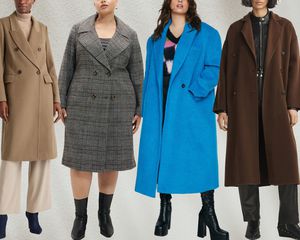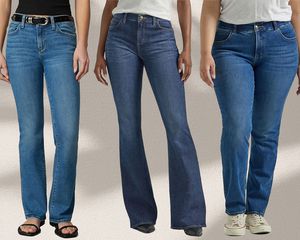:max_bytes(150000):strip_icc()/tailoringjeans-92cfc4a90d434c2b8274e20608807d70.jpg)
Dion Lamar Mills for Byrdie
Finding the perfect fitting pair of jeans off the rack is nearly impossible. And yet, jeans remain one of the rarest items to bring to a tailor. Sure, it's important to shop for jeans that fit your figure well (especially in some hard-to-alter regions, such as around the hips), but there are things you can do to customize an almost-perfect pair of denim and create a made-to-measure look.
However, altering jeans is a little more difficult than other garments because they change in size over time according to Molly Roe, a Stitch Fix stylist. She suggests washing your jeans a few times before bringing to a tailor.
Because of the added challenges, we've rounded up our best tips to guide you on your jean alternation journey, from how to hem jeans so that they fit your shape perfectly to how to decipher which types of denim can even be tailored to begin with.
Read on for expert approved tips on tailoring your jeans.
Meet the Expert
- Molly Roe is a Stitch Fix stylist.
- Robin Chalfin is a professional tailor and owner of Toolkit Tailoring Studio based in Boston, Massachusetts.
Know Which Jeans You Can Alter
When it comes to denim, some types aren't easy to alter. A pair of jeans should already fit you well in the rise (where the waistband sits on your body), hips, and crotch. If the jeans sit too high or low on the waist, don't cling to your hips, squeeze you too tightly, or don't fit properly at the crotch, it's time to part ways and keep shopping for another pair that fits in these areas.
Robin Chalfin, a professional tailor and owner of Toolkit Tailoring Studio based in Boston, Massachusetts, believes the most important thing to do before tailoring a pair of jeans is understanding what you are trying to achieve.
"You can slim a leg on a fuller shape but you can’t recut a slim leg. Think through your end goal and evaluate whether it’s worth your money," she says.
That being said, there are other fit issues (such as a too-long length, gapping at the waist, or overly baggy legs) that can easily be fixed by taking them to a tailor to take in (or remove) excess fabric. Bottom line: know where jeans should fit, and know when a tailor can lend a helping hand.
Shorten Long Jeans With Hemming
Have you found a pair of jeans that fit your shape but not your length? Good news: Shortening too-long jeans (aka hemming jeans) is the easiest alteration you can make to denim pants. A tailor or seamstress can shorten them, either by cutting off some fabric and redoing the hems or taking up the hems in a way that doesn't involve cutting the fabric.
When it comes to cutting jeans shorter, your tailor will mark the correct length with chalk or pins. You can, and Chalfin believes you should, ask them to give you an "original hem" (also called a "European hem"), which involves removing the original hems of the jeans and re-attaching them after the excess fabric is cut from the legs. While this can add cost to your alterations, it will ensure your jean hems look right. (Plus, it's easier than having the tailor reproduce the right thread, stitching method, and original spacing between the stitches—this is especially true if you're altering a pair of designer jeans, which are often recognizable by the unique fading or stitching on their hems).
If you're looking to hem jeans by more than one to two inches, you may need to change the jean's leg shape, which can be a complicating factor in bootcut or flare jeans styles. And, if your jeans are faded or distressed, they'll need to be cut at a place that looks consistent with the style. No matter what, be sure to bring the shoes you'll wear most often with the jeans so that you get the right length.
If you'd rather not cut your jeans, you can ask a tailor to do an "inside hem." Unlike the original hem method, this one doesn't involve any cutting of fabric. Instead, your tailor will fold the extra length under and stitch it in place to make the jeans appear shorter. Since this doesn't give you a finished hem look, it's better as a short-term solution (think: when you're borrowing a pair of jeans from a friend).
Taper Baggy Jeans for a Tighter Look
Maybe you stumbled upon a pair of denim that fits well through the waist and hips, but the thighs are too baggy. Or, perhaps you've got an old pair of straight-leg jeans and skinny jeans are more your style now. Either way, tapering jean legs to make them slimmer is a pretty straight-forward alteration for a good tailor, as long as you're not drastically changing their style (think: going from flare to skinny).
To taper your jeans for a more streamlined leg look, the tailor will have you try on the jeans then pin along the inseams (the line of stitching running down the inner leg). The jeans will then be turned inside out and sewn to create a more slender ("tapered") leg opening. The extra fabric on your tailored jeans can be cut away or just sewn inside, depending on the excess amount.
That being said, Chalfin recommends thinking twice before going this route. "Look at the shape you are starting with," she advises, "Since the leg needs to be opened up to the floor to achieve this correctly, it might be more cost effective to invest in a new pair."
Also bear in mind: If you're taking in the calves of jeans as well as the thighs, the bottoms may need to be re-hemmed. Ask the tailor for an "original hem" to give jeans an unaltered look.
Alter the Waist Strategically
Waist gapping can be an issue with denim pants, but an experienced tailor can alter a waistband to nip it in a bit. Just be sure not to take in the jeans more than one to one and a half inches at the waist, as doing more can change the pocket positioning and front shaping of the jeans. Not to mention, you'll likely have to alter the hips as well to maintain the proper line. It's often easier (and less expensive) to either wear a belt or find a pair of jeans that fits your hips better.
Wash Your Denim Before Altering to Avoid Shrinking
Before taking a new pair of jeans for alterations, you should wash them a couple of times first. To wash jeans, turn them inside out and launder them in cold water on the delicate setting of your machine, then leave them to hang dry. "Never dry in a hot dryer," says Chalfin. Putting your jeans through a few wash cycles will ensure they won't shrink further and that the tailor is working with the "final" shape and length.
Go to a Denim-Experienced Tailor
"When you invest in denim you want to insure they handle a pair of jeans like they would handle a suit," Chalfin says, "Ask if they retain the original hem."
If you're buying a new pair of jeans that requires a few tweaks, ask the store where you shopped if they have alternation services—some department stores offer free or discounted hemming and some even specialize in denim alternations.
Beyond that, ask your network for their recommendations. "You don’t want to end up with an irreversible chop," warns Chalfin.
Finally, make sure to ask the tailor if they have experience altering denim fabric in particular, as tailoring jeans can involve special stitching techniques and sewing equipment.
Lead image product provided by Levi's.



